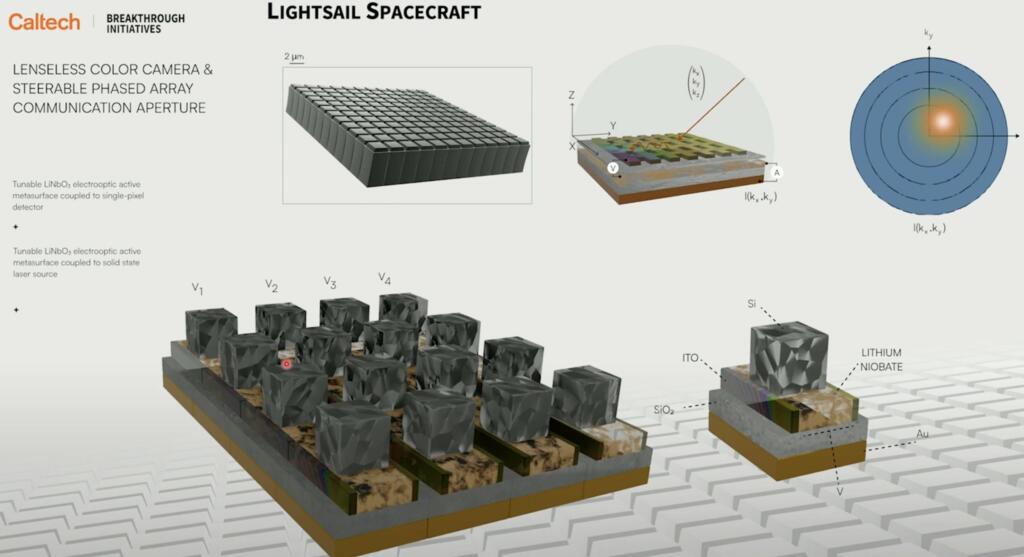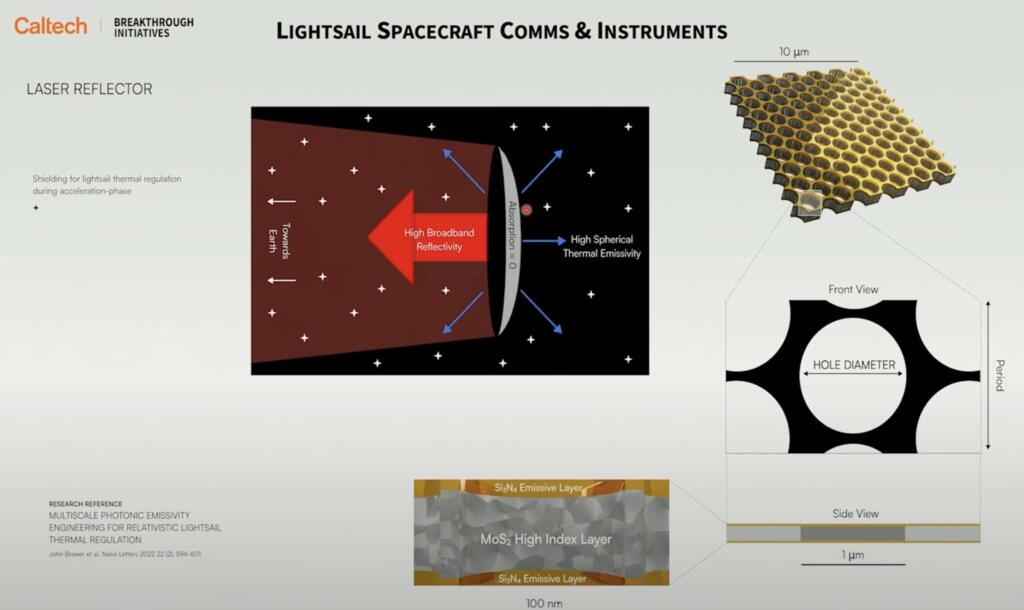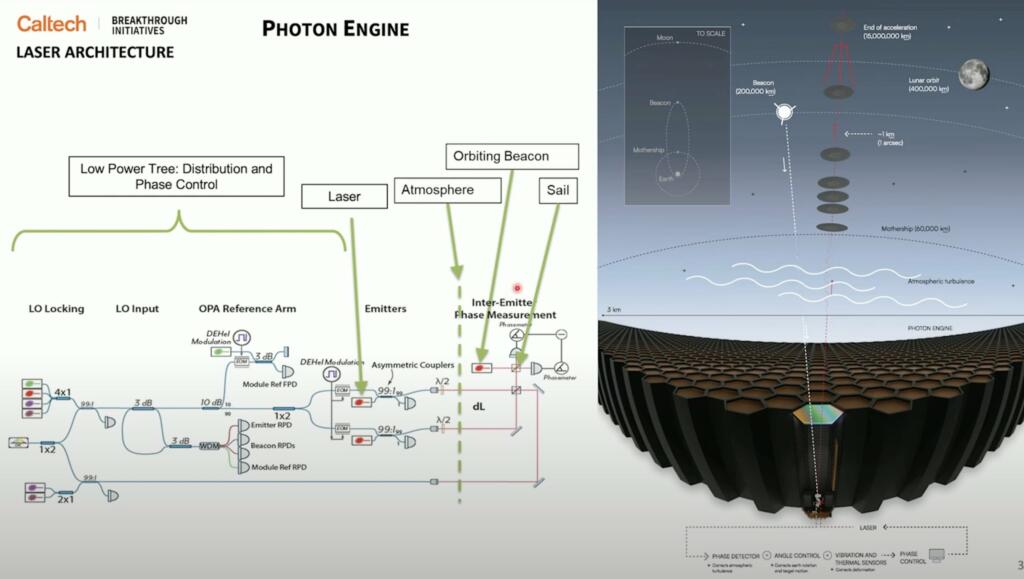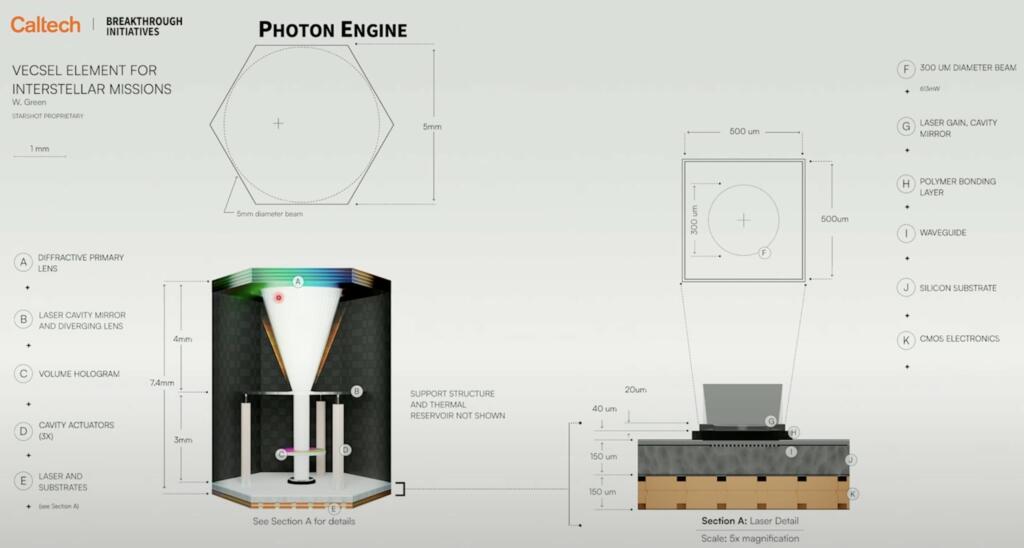Breakthrough Starshot is a research and engineering project by the Breakthrough Initiatives to develop a proof-of-concept fleet of light sail interstellar probes named Starchip. It is funded by billionaires Yuri Milner and Mark Zuckerberg. Caltech is the doing a lot of the research and design and they have generated some designs for the probes which need to be 4 meters in diameter and weigh 1 gram. There will be precursor missions to planets in our solar system, kuiper belt asteroids and Oort cloud asteroids. This will lead to the mission around 2050 to a flyby mission has been proposed to Proxima Centauri b, an Earth-sized exoplanet in the habitable zone of its host star, Proxima Centauri, in the Alpha Centauri system. At a speed between 15% and 20% of the speed of light it would take between 20 and 30 years to complete the journey, and approximately 4 years for a return message from the starship to Earth.
The funded program has made significant progress with the designs but there is still a long way to go to develop all parts of the laser propulsion and communications systems.

















Brian Wang is a Futurist Thought Leader and a popular Science blogger with 1 million readers per month. His blog Nextbigfuture.com is ranked #1 Science News Blog. It covers many disruptive technology and trends including Space, Robotics, Artificial Intelligence, Medicine, Anti-aging Biotechnology, and Nanotechnology.
Known for identifying cutting edge technologies, he is currently a Co-Founder of a startup and fundraiser for high potential early-stage companies. He is the Head of Research for Allocations for deep technology investments and an Angel Investor at Space Angels.
A frequent speaker at corporations, he has been a TEDx speaker, a Singularity University speaker and guest at numerous interviews for radio and podcasts. He is open to public speaking and advising engagements.


This is a solution in search of a problem. Just build bigger space telescopes. We don’t need to wait until 2070 to get close-ups of Proxima Centauri b.
Hmmm… I probably should go read the glossy before commenting, as my usual objections are likely answered there. But hêll, who has time to read all that just to make a few comments? As the InterWebz sez, TLDR. Too long, didn’t read.
So, somewhere up there, was “1.5 GWh” … and “4 hours” of acceleration. Simple, that computes down to 400± MW of nearly continuous illumination. Realizing that the illumination beam won’t so conveniently stay hyper-focussed upon the receding interstellar probe, the illumination likely starts higher at maybe 1,000 MW, and diminishes as a function of d² like all radiative processes.
OK. 1,000 MW.
And somewhere else up there, I spied a 70% theoretical impulsive efficiency. So, 700 MW of actual photon thrust. Remembering that the reflective thrust equation is (F = 2ηP/c) where η is ‘coupling efficiency’, then
F = 2 × 0.70 × 1,000,000,000 ÷ 299,792,458
F = 4.67 N
The mass is what again, 15 grams all in? 0.015 kg. Again, physics:
F = ma (mass times acceleration) sooo
a = F/m
a = 4.67 N ÷ 0.015 kg
a = 311 m/s²
If instead, we go with the 400 MW bit ‘average’ (which is substantially easier to calulate with), then
F = 2 × 0.70 × 400,000,000 W ÷ 299,792,458
F = 1.9 N
a = 1.9 N ÷ 0.015 kg
a = 125 m/s²
V = at = 125 × ( 4 h × 60 × 60 )
V = 1,800,000 m/s (div by 299,792,458 = c)
V = 0.00598 c
Clearly that is not a meaningful percent of ‘c’. However, it IS about 1 AU per day. VERY good for buzzing around the planetary Solar system. A few days to Jupiter. A few weeks to Pluto. A couple of months to the more interesting Kuiper objects or Oört cloud iceballs.
________________________________________
The purpose of going through that bit is to also highlight the profoundly different energy and intensity (and duration) requirements to get a chip probe to speeds anywhere near 20% of c. This exercise got a 15 gram, 4 m in diameter chip probe to 1 AU per day. VERY respectable, but totally insufficient to get to α-Centauri.
Working backwards for 20% of c, it comes out to:
V = at
(20% of 299,792,458) = 1,000 m/s² (guess) • t
t = 60,000 s
and
1,000 m/s² = 8 times 125 m/s², so power must be 8× or 3,200 MW illumination.
If (distance = ½at²) then
d = ½ × 1000 m/s² × 60,000² sec
d = 1,800,000,000,000 m
d = 12 AU
What? That’s ridiculous. (Goat goes back, and thinks about how he might have missed a few decimal points or something. And finds nothing wrong, again.)
________________________________________
Well, in the absence of a contrary computation, sometimes it is best to work with the original again.
d = ½at² where (a = 125 m/s²) and (t = 14,000 s);
d = 12,250,000,000 m
d = 0.082 AU
Now see, that’s much more ‘realistic’ and while not matching the stuff above very well (remember, I’ven’t read the original in detail yet), its in the ‘ballpark’.
Again in ‘ballpark’ numbers, is it all that different in estimates between 0.082 AU to get to 0.6% c and 12 AU to get to 20% c, 33× faster? No, not really.
So again, the 12 AU acceleration is a show stopper.
No amount of fancy adaptive optics and thru-atmosphere laser propagation is going to go 12 AU and still focus on a spot only 4 meters across. Hêll … we can’t image Pluto from Earth (granted, 40 AU, but still) to a resolution better than 500 km, or a ‘fuzzy blob’. And again, realistically, we’ve not yet deployed huge synthetic aperture space or Lunar telescopes to do better imaging. Of the ‘hugeness’ required to focus the 3 gigawatts on a receding 4 meter dot, out near Saturn.
This topic, again, is why I fear our belief in Magic is going unanswered. It takes physics to do any of this stuff, and it takes ‘napkin math’ to show that it isn’t fiction and magical thinking.
So far, I remain unimpressed.
Or, as Brian says, ‘orders of magnitude’ are needed in EVERY area of this magical thought exercise.
PS: … PRETTY PICTURES though!!! A+ for that.
⋅-⋅-⋅ Just saying, ⋅-⋅-⋅
⋅-=≡ GoatGuy ✓ ≡=-⋅
I wonder, would the emitters needed to propel the spacecraft to relativistic speeds be good for some space debris deorbiting.
They’d be over kill by a lot of orders of magnitude. Though I suppose that does imply that you wouldn’t have to identify where the debris actually was, you could just scan orbital space, omitting the part where stuff was supposed to be, and vaporizing anything out of place.
I continue to have doubts about transmitting any data back with that small of a power budget. Perhaps relaying it back via a long line of probes might be feasible.
at 4 light years away, you would need 10 thousand probes for each one to be the distance from the Sun to Pluto.
Only “feasible” solution , like super easy piece of cake level, haha, would be to position 2 probes at the Solar Focus Line of each star. Precisely aligned to each other. Then they could transmit with zero error rate with only a few watts of power.
That’s exactly what a recent preprint proposes.
I have always wondered if this was a Russian intelligence op to raise Western money to build powerful space lasers, which the Russians would then take control of to use as weapons.
why and how would the Russians take control?
It’s more probable that it’s secretly financed by the Pentagon, so the Russians won´t protest.
Starshot doesn’t plan on building lasers in space. Phil Lubin has discussed the idea in his De-Star papers though.